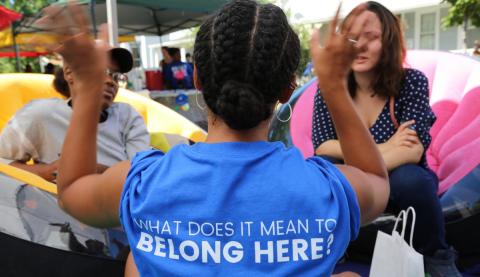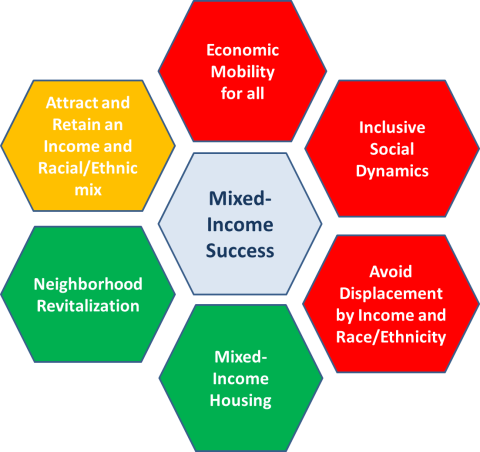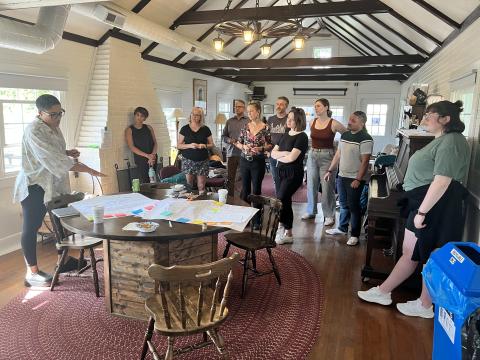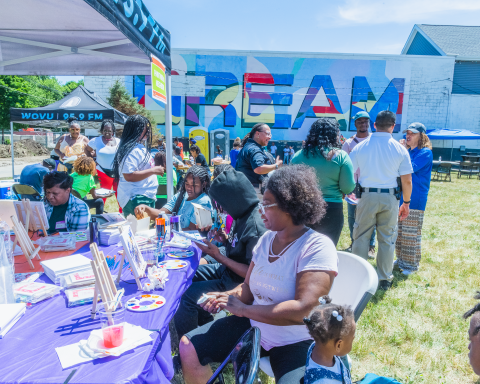In our second decade, we are making some big changes! Taking the lessons we learned from our first decade as The National Initiative on Mixed-Income Communities (NIMC), we are advancing our quest to demonstrate that it is possible to foster unified, diverse communities where everyone thrives and experiences belonging.
What We Learned in Our First Decade
Our research and consultation at the National Initiative on Mixed-Income Communities at Case Western Reserve University revealed the limitations of investments focused predominantly on housing. While these investments have led to higher quality housing and neighborhood revitalization, they have fallen far short of fostering social inclusion and economic mobility. Residents are often either physically or culturally displaced (still in the community, but no longer feel like they belong).
In brand new mixed-income housing across the country, redevelopments consistently have experienced that without intentional social weaving and capacity-building efforts, residents remain socially isolated and economically disconnected.
We have found that social weaving and capacity building are key to maximizing the impact of affordable, quality and stable housing in order to promote economic mobility.
After our first decade, we committed a year to reflect, recommit and reimagine the future of NIMC. Learn more about that journey.
Image description:
Infographic with five hexagons arranged in a circle around one hexagon, each with one of the following labels, clockwise from the top: Economic mobility for all; Inclusive social dynamics; Avoid displacement by income and race/ethnicity; Mixed-income housing; Neighborhood revitalization; Attract and retain an income and racial/ethnic mix; and in the center hexagon, Mixed-income success.
The image is meant to convey how Mixed-income success (in the center) is defined by each of the surrounding elements (Economic mobility for all; Inclusive social dynamics; Avoid displacement by income and race/ethnicity; Mixed-income housing; Neighborhood revitalization; Attract and retain an income and racial/ethnic mix).
The hexagons containing the labels Economic mobility for all, Inclusive social dynamic and Avoid displacement by income and race/ethnicity are red in color to convey consistent failure at achieving these goals in mixed-income developments across the country.
The hexagons containing the labels Mixed-income housing and Neighborhood revitalization are green to convey progress and success in these areas.
The hexagon labeled Attract and retain an income and racial/ethnic mix is yellow to convey mixed success in these areas.
Next Phase of Our Social Change Quest
NP3 emerged to provide strategies for social weaving and capacity building, seeking to work alongside transformative leaders in transformative contexts in transformative moments. Together, we believe we can nurture growth and opportunity for people in communities who seek to ensure thriving and belonging for all.
This happens at a hyper-local level, working with individuals, who are active on their block, which links to other blocks to create a micro-neighborhood, which advocates for its residents and aligns with others as part of a larger community.
Demonstration and Learning Hub
For over eleven years, NIMC was proud to identify as an impact research center, focused on research, evaluation, consulting, and technical assistance that promoted urban equity and inclusion. However, those who followed our journey after our 10-year anniversary know that we invested time to reflect, recommit and reimagine our impact, lessons learned and vision for our second decade. One key change was to become a Demonstration and Learning Hub. We will be doing more implementing than consulting, more deeper, extended place-based engagements over short-term efforts, and seeking partners who are eager to foster racial healing and collective liberation.
Our first Demonstration Zone is right here in Cleveland, Ohio. We have been working intensively in the Greater Buckeye community on Cleveland’s east side for more than five years, serving as the quarterback for the federally funded Woodhill-Buckeye Choice Neighborhoods Initiative redevelopment project. Since early 2025—in close partnership with Neighborhood Connections and Burten, Bell, Carr Development Inc.—we have begun working with neighborhood leaders more broadly across the entire Greater Buckeye community, seeking to collaboratively foster a unified multiracial community where everyone has a voice and feels a sense of belonging.
As a university-based center, learning has been and always will be part of our DNA. As we continue this work, we will document our emerging insights and work with non-profits, faith-based institutions and community-based organizations to replicate this approach across the county.





